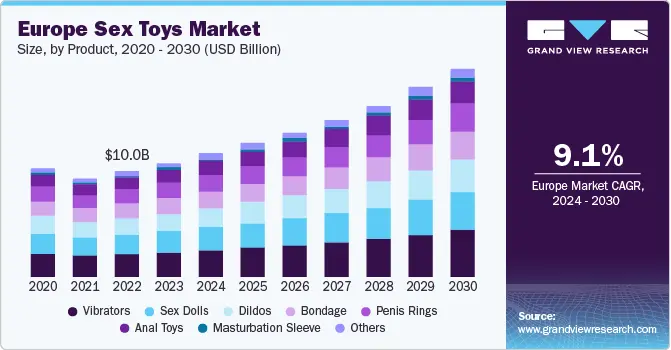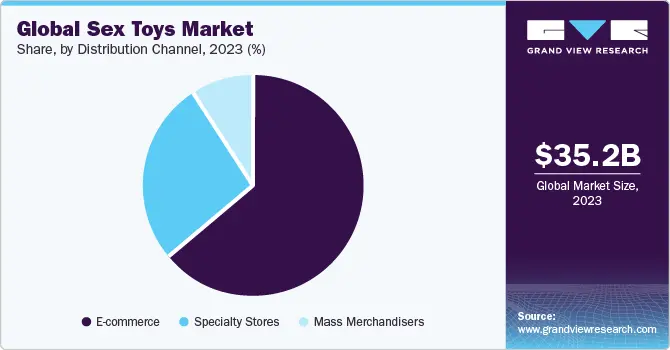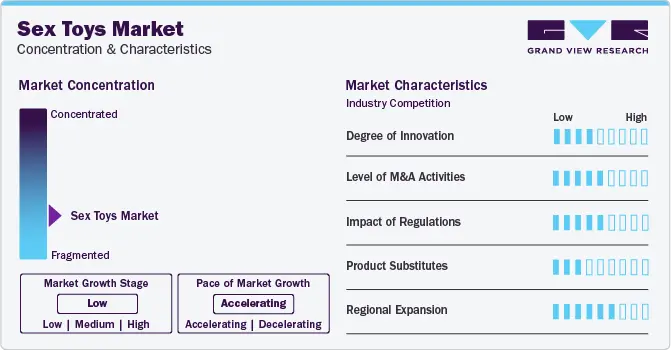The global sex toys market is entering a new era of rapid growth and innovation. In 2023, the market reached USD 35.2 billion. Market experts forecast that the global sex toys market will grow at a CAGR of 8.69% from 2024 to 2030.
This growth reflects shifting attitudes toward sexual health and wellness. More people now see vibrators and other adult products as tools for self-care and emotional well-being. The rise of app-controlled and smart sex toys is also changing how users engage with pleasure products.
Companies like Gaia in Love are leading this transformation. By combining advanced technology with elegant design, they help normalize conversations around sexual experiences. At the same time, they meet growing demand across North America, Asia Pacific, and Latin America.
In this report, we explore key trends shaping the global sex toys market. We also examine regional growth, product innovation, and the role of sexual wellness products in modern lifestyles.
Table of Contents
- Overview of the Global Sex Toys Market
- Key Trends Shaping the Industry
- Growth of Vibrators for Women
- Rise of Smart Sex Toys and Pleasure Tech
- Regional Insights: North America, Asia Pacific, and Latin America
- Innovation in Sexual Wellness Products
- E-Commerce and Consumer Behavior
- Forecast: What to Expect by 2030
- FAQ: Common Questions About the Sex Toy Market

1. Overview of the Global Sex Toys Market
The global sex toys market has grown rapidly in recent years. In 2023, it reached an estimated value of USD 35.2 billion. Analysts forecast continued expansion through 2030, with a projected CAGR of 8.69%. This signals steady demand across all major regions.
This market includes a wide range of products. Top-selling categories include women’s vibrators, smart sex toys, and anal products, according to recent sales data. Their popularity reflects a shift in public attitudes toward sexual health and wellness. Consumers now view sex toys as essential tools for pleasure and self-care.
Technological advancements also support this growth. Features like app control and personalized settings make these products more appealing. Users want experiences that match their preferences and lifestyles.
Companies in the sex toy industry now invest heavily in product design, R&D, and branding. They aim to serve global markets through e-commerce, especially in North America, Asia Pacific, and Latin America. As demand rises worldwide, competition among brands continues to intensify.
The global sex toys market is no longer niche. The sex toy market is gaining mainstream visibility and wider cultural acceptance across global regions. This shift sets the stage for continued innovation and long-term growth during the forecast period.
2. Key Trends Shaping the Industry
Several key trends are driving growth in the global sex toys market. First, there is a clear shift in how people view sexual wellness. More individuals see pleasure as part of a healthy lifestyle. This mindset boosts the demand for vibrators for women and other sexual wellness products.
Second, technology continues to change the industry. Smart sex toys with Bluetooth, app control, and AI features are gaining popularity. These innovations allow users to customize their experience in real time, adding both convenience and intimacy. Personalized pleasure is now a top priority.
Third, social acceptance of sexual wellness products continues to increase across major global markets. In regions like North America and Europe, consumers talk more openly about sexual health. This reduces stigma and encourages people to explore products like rabbit vibrators or remote-controlled toys.
Fourth, the growth of e-commerce has significantly improved consumer access to sexual wellness products across global markets. Online stores offer privacy, variety, and discreet delivery. This trend is especially important in Asia Pacific and Latin America, where online shopping is rapidly expanding.
Finally, more brands are focusing on inclusive design and body-safe materials. Consumers want high-quality sex toys that are safe, easy to use, and built to last. Medical-grade silicone and thoughtful shapes now dominate the market.
Together, these trends reflect deeper cultural and technological shifts. The sex toy market is evolving fast, and brands that adapt will continue to lead during the forecast period.
3. Growth of Vibrators for Women
Vibrators for women remain the most dominant product category in the global sex toys market. Their popularity reflects both rising consumer awareness and evolving social norms. Public discussions around sexual health are becoming more common across global markets. As a result, many women feel empowered to explore products that support intimacy and well-being.
In 2023, the vibrators segment represented a significant portion of global sex toy market revenue, according to industry data. Market analysts project that this growth will continue through 2030. High-quality materials, elegant design, and functional versatility make vibrators appealing to a broad range of users.
Brands now focus on creating innovative products that serve multiple needs. Some devices offer clitoral stimulation, while others combine internal and external use. Dual-purpose models are especially popular because they offer more options in a single device.
The demand for app-controlled and remote-access functions has also grown. These features help women personalize their sexual experiences. They also support long-distance intimacy and private exploration.
In emerging markets like Asia Pacific and Latin America, younger consumers are driving demand. They are tech-savvy, wellness-oriented, and open to trying new products. This shift presents opportunities for global brands to expand their reach.
Overall, vibrators for women have become mainstream products in the global sex toy market. They are mainstream products that support sexual wellness, boost confidence, and improve quality of life.
4. Rise of Smart Sex Toys and Pleasure Tech
Smart sex toys are reshaping the future of the global sex toys market. These innovative products use technology to deliver more personalized, interactive, and satisfying experiences. As a result, they are quickly gaining market share across all regions.
Today’s consumers expect more than simple vibration modes. They want features like app control, Bluetooth connection, and AI-powered responses. These tools allow users to adjust intensity, rhythm, and timing based on their real-time preferences. This level of personalization is changing how people define pleasure.
The launch of app-controlled vibrators has also enabled remote intimacy. Long-distance couples now use these devices to stay connected. During the COVID-19 pandemic, sales of such products surged, and demand remains high.
Companies like Gaia in Love continue to invest in pleasure tech. Their smart vibrators support various functions, including dual stimulation, heating, and interactive control. One example is the Luxe Insight Pro, an endoscopic vibrator designed for deeper exploration and enhanced user control.
These innovations reflect broader trends in the sex toy industry. In this market, design and technology increasingly work together to enhance sexual experiences.
Smart sex toys also appeal to younger, tech-savvy users. This group is growing fast in North America and Asia Pacific. They value seamless integration, sleek design, and digital freedom.
As the market for sex toys evolves, pleasure tech will play a leading role. It combines emotional connection with technical innovation, pushing the industry toward a smarter, more inclusive future.

5. Regional Insights: North America, Asia Pacific, and Latin America
The global sex toys market shows distinct regional patterns. North America, Asia Pacific, and Latin America lead in growth and consumer demand.
North America remains the largest market, with a 33.24% revenue share in 2023. High consumer awareness and cultural acceptance support strong sales. Buyers in this region prioritize premium features, such as app control and body-safe materials. E-commerce is the main channel, offering convenience and privacy.
Asia Pacific is the fastest-growing region. Young, tech-savvy consumers are driving demand, especially in China, Japan, and South Korea. Local manufacturing also gives brands in this region a cost advantage. Australia has also seen rising demand for couples sex toys, reflecting shifting intimacy preferences among younger consumers.
As sexual wellness becomes more normalized, more women explore vibrators for the first time. The rising popularity of app-controlled devices shows strong potential for continued expansion.
Latin America is also gaining momentum. In countries like Brazil and Mexico, social attitudes are shifting. An increasing number of consumers view sex toys as essential tools for personal wellness and sexual health.
Online platforms help reach consumers who seek discretion. This is especially important in conservative markets. Demand for vibrators for women and anal toys is increasing steadily.
Each of these regions offers unique opportunities. Brands that understand local preferences and invest in education can build strong market positions. Regional diversity also highlights the global appeal of sexual wellness products and their role in improving quality of life.
6. Innovation in Sexual Wellness Products
Innovation plays a central role in the growth of sexual wellness products. Consumers now expect more than basic functions. They look for high-quality sex toys that combine technology, safety, and thoughtful design. As a result, brands are investing heavily in research and development.
The most successful products solve real user needs. For example, some vibrators improve blood flow and reduce stress. Others help address issues such as low libido or menopausal discomfort. These health-related benefits increase the appeal of sexual wellness products across all age groups.
Material quality plays a key role in consumer purchasing decisions. Consumers prefer safe, durable options like medical-grade silicone. Products must feel comfortable and be easy to clean. Features like waterproofing and silent operation are now standard expectations.
Design innovation is another key factor. Vibrators for women now come in a variety of shapes, sizes, and functions. Some combine internal and external stimulation. Others include heating elements or soft-touch finishes to enhance sensory experience.
Brands like Gaia in Love focus on blending form with function. Their devices use ergonomic shapes and intuitive controls. Many also support remote or app-based operation, meeting the demand for smart sex toys.
Innovation in this space is not just about pleasure. It also reflects a deeper commitment to sexual health and personal empowerment. As consumers grow more informed, they choose products that align with both their values and their lifestyles.
7. E-Commerce and Consumer Behavior
E-commerce has become the leading sales channel in the global sex toys market. In 2023, online platforms accounted for 63.8% of total product sales. This shift reflects changing consumer behavior and rising demand for privacy, convenience, and product variety.
Consumers now prefer to browse, compare, and purchase sexual wellness products from the comfort of their homes. Online stores offer discreet packaging and detailed product information, making it easier for first-time buyers to feel confident. This trend is especially strong among younger adults, who are more comfortable with digital transactions.
Social media also plays a role in shaping consumer behavior. Influencers and wellness brands use these platforms to normalize conversations around sexual health. The growing popularity of vibrators and smart sex toys reflects changing values and online habits. Product functionality, media exposure, and public conversations all contribute to this growing trend.
In regions like Asia Pacific and Latin America, mobile-first shopping continues to rise. Consumers use smartphones to explore product reviews and engage with brands in real time. E-commerce enables these interactions and supports rapid market expansion.
To succeed in this environment, brands must prioritize user-friendly websites, responsive customer service, and fast shipping. Companies like Gaia in Love also build trust by offering educational content and expert recommendations.
The e-commerce boom is not temporary. It reflects a lasting change in how people shop for sex toys and manage their sexual wellness. This behavior will continue to shape the market for sex toys during the forecast period.
8. Forecast: What to Expect by 2030
The global sex toys market is expected to maintain strong momentum through 2030. Analysts expect the market to reach USD 65 billion by 2030, led by innovation, social shifts, and online expansion. This reflects a sustained CAGR of 8.69%, supported by product innovation, cultural acceptance, and digital commerce.
Vibrators for women will continue to dominate the market. Their versatility, design improvements, and health-related benefits make them a long-term favorite. Analysts forecast continued growth in demand for smart sex toys, driven by consumer interest in personalization and remote functionality. Features like app control, interactive feedback, and AI integration are reshaping expectations and pushing the industry forward.
Regions such as Asia Pacific and Latin America will drive future growth. Their expanding middle class, growing sexual health awareness, and mobile commerce trends create ideal conditions for market expansion. North America and Europe will remain stable leaders, with strong demand for premium, high-quality products. This includes rising interest in wand vibrators, particularly in Germany and the UK.
In addition, e-commerce will further increase its share. Online channels offer global reach, helping brands scale quickly. Consumers will continue to favor platforms that offer education, community, and reliable service.
Innovation will define the next phase of this industry. Companies that focus on user experience, safety, and emotional connection will stand out. The market for sex toys is not just growing in numbers—it is evolving in purpose.
Major industry events like the AVN Novelty Expo help shape global trends. They also provide insight into future products and shifting buyer interests. Regional expos such as the Asia Adult Expo help raise global visibility for the industry. They also boost business momentum across the Asia Pacific sex toy market.
By 2030, sexual wellness will become an essential part of mainstream health and lifestyle. The sex toy industry is preparing for that future now.

9. FAQ: Common Questions About the Sex Toy Market
Q1: What are the primary drivers behind the projected growth of the global sex toy market through 2030?
Key drivers of market growth include rising sexual wellness awareness, higher product standards, and expanding cultural acceptance. Smart sex toys and e-commerce also play key roles in expanding access and visibility across markets.
Q2: What factors explain the market leadership of vibrators for women?
Vibrators offer both pleasure and health benefits. Their ability to support clitoral stimulation, reduce stress, and improve intimacy makes them a top choice among consumers. Their versatility also boosts long-term popularity.
Q3: How important is technology in modern sex toys?
Technology is essential. Smart sex toys incorporate app control, AI-driven responses, and Bluetooth functionality to support personalized and interactive user experiences. These advancements enhance the user experience by offering real-time customization and remote control.
Q4: Which regions show the most potential for market growth?
Asia Pacific and Latin America are growing the fastest. Cultural shifts, mobile-driven shopping, and rising interest in sexual wellness products explain this regional growth. North America remains the largest market.
Q5: What key developments will drive the evolution of the sex toy industry through 2030?
The market will focus on high-quality design, digital integration, and wellness-centered messaging. Products will be safer, smarter, and more inclusive. E-commerce will continue to dominate distribution channels.




